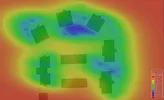Ludwigshöhe: Optimization Potential for the Planning and Performance of a Borehole Heat Exchanger Array
The use of geothermal energy for heating purposes has gained great interest in the last years due to high heating cost and increase of environmental awareness.
For the planning of a geothermal system, the understanding of heat transport mechanism at local scale is crucial. Thermal properties of the subsurface are important input parameters, since they are not variable and the value given in literature are too unspecific. Recently, numerical simulation are recommended additionally to the analytical calculation, to make reliable forecast of subsurface’s thermal development, which affect the heating performance (see Figures).
The project aims to stress the importance of the planning phase, where input parameters have to be acquired precisely, in order to exploit the full potential of the geothermal energy. For model validation, depth-related temperature measurements at two locations has been installed:
at the borehole heat exchanger (BHE) to observe the thermal development at immediate vicinity of an operating BHE
at the groundwater monitoring well, to record the impact of BHEs operation
Research objectives:
- Establish a detailed finite-element model (FEFLOW®) of BHE field of Ludwigshöhe, Kempten, Germany
- Validate with temperature data recorded spatially and temporally resolved
- Sensitivity analysis of the input parameters
- Draft an optimization proposal
Contributions to SDG
Responsible
M. Sc. Katharina Albert; Dr. Kai Zosseder
Project duration
completed
Publications
Albert, K., Schulze, M., Franz, C., Koenigsdorff, R., Zosseder, K. (2017). Thermal conductivity estimation model considering the effect of water saturation explaining the heterogeneity of rock thermal conductivity. Geothermics 66, 1-12. http://dx.doi.org/10.1016/j.geothermics.2016.11.006




